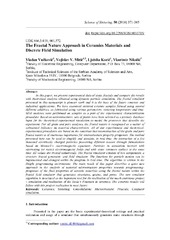Приказ основних података о документу
The fractal nature approach in ceramics materials and discrete field simulation
| dc.creator | Vučković, Vladan | |
| dc.creator | Mitić, Vojislav V. | |
| dc.creator | Kocić, Ljubiša | |
| dc.creator | Nikolić, Vlastimir D. | |
| dc.date.accessioned | 2019-03-27T09:48:38Z | |
| dc.date.available | 2019-03-27T09:48:38Z | |
| dc.date.issued | 2018 | |
| dc.identifier.issn | 0350-820X | |
| dc.identifier.uri | https://dais.sanu.ac.rs/123456789/5249 | |
| dc.description.abstract | In this paper, we present experimental data of static fractals and compare the results with theoretical analysis obtained using dynamic particle simulation. The fractal simulator presented in this manuscript is pioneer work and it is the base of the future concrete and industrial applications. We have examined sintered ceramic samples formed using several different additives, as fabricated using various parameters, sintering temperature and time. SEM analyses were performed on samples as a part of the experimental characterization procedure. Based on microstructures, sets of points have been selected as a primary database input for the theoretical-experimental simulation to model the processes that describe the experiment. For all grain and pore analyses, the fractal nature is recognized as a matter of substantial influence on material characteristics. All of our experimental and theoretical-experimental procedures are based on the construct that reconstruction of the grain and pore fractal nature is of enormous importance for microstructure property prognoses. The method presented here can be used to simplify and simulate, in real time, the interaction of a few thousand electrically charged particles possessing different masses through formulations based on Maxwell’s electromagnetic equations. Particles in simulation interact with alternating (or static) electromagnetic fields and with static ceramics surface at the same time. All values are treated numerically. The fractal simulator consists of two components, a structure fractal generator, and field simulator. The functions for particle motion can be implemented and changed within the program in real time. The algorithm is written in the Delphi programming environment. The main result of this paper describes a quite new approach in the analysis of material microstructure properties towards programming-prognoses of the final properties of ceramic materials using the fractal nature within the fractal field simulator that generates structures, grains, and pores. The new simulator algorithm is developed as the important tool for the realization of the much ambitious project – simulation and realization of the Tesla’s Fountain in ceramics. The concrete results will follow with this project realization in near future. © 2016 Authors. Published by the International Institute for the Science of Sintering. | en |
| dc.publisher | ETRAN | |
| dc.rights | openAccess | |
| dc.rights.uri | https://creativecommons.org/licenses/by/4.0/ | |
| dc.source | Science of Sintering | |
| dc.subject | ceramics | |
| dc.subject | computer simulation | |
| dc.subject | consolidation | |
| dc.subject | fractals | |
| dc.subject | microstructure | |
| dc.subject | sintering | |
| dc.title | The fractal nature approach in ceramics materials and discrete field simulation | en |
| dc.type | article | en |
| dc.rights.license | BY | |
| dcterms.abstract | Митић, Војислав В.; Коцић, Љубиша; Николић, Властимир Д.; Вучковић, Владан; | |
| dc.citation.spage | 371 | |
| dc.citation.epage | 385 | |
| dc.citation.volume | 50 | |
| dc.citation.issue | 3 | |
| dc.identifier.wos | 000452976600009 | |
| dc.identifier.doi | 10.2298/SOS1803371V | |
| dc.identifier.scopus | 2-s2.0-85062992383 | |
| dc.type.version | publishedVersion | |
| dc.identifier.fulltext | https://dais.sanu.ac.rs/bitstream/id/16575/Vuckovic_Science-of-Sintering_50_2018_371-385.pdf | |
| dc.identifier.rcub | https://hdl.handle.net/21.15107/rcub_dais_5249 |

